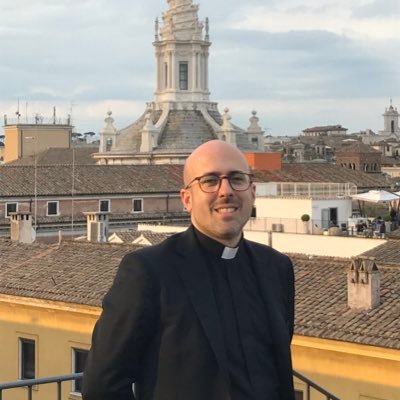On February 11, 1929, the Lateran Pacts – accords between the Kingdom of Italy and the Holy See – were signed. They established relations between the two entities, guaranteeing through the Constitution of the Vatican City, the Pope’s total freedom and independence. We discussed this with Fr. Roberto Regoli, historian and professor of Church History at the Pontifical Gregorian University.
Benjamin Crockett:
Before we approach the understanding of the Lateran Pacts, what was the situation in Italy before the drafting of the Pacts?
Fr. Roberto Regoli:
Professor at Pontifical Gregorian University
The Lateran Pacts are a consequence of the so-called “Roman question.” What happened? On September 20, 1870, the troops of the Kingdom of Italy entered Rome, which was the Pope’s last remaining territory. And the Pope then, Pius IX, lost every territorial power. That is the Pope was no longer a territorial, temporal sovereign, but only a spiritual sovereign. What happens from that moment on is that Pius IX and all of his successors try to find a new independence because they find themselves in Italy under a sovereign. And the issue is important because when the First World War broke out, the nations at war with Italy that had representatives to the Pope, with ambassadors, weren’t able to keep their ambassadors to the Pope because Italy could not guarantee their independence and not only independence, but safety. At that point it is understood that the Pope, under the dominion of another sovereign cannot fully exercise his prerogatives, his powers, relations with all the other States of the world. So, at the end of the First World War, the urgency of finding a solution to the Pope’s independence was addressed more energetically and so the Lateran Pacts are a response to an attempt at papal independence, shared with Italy.
Benjamin Crockett:
Specifically then, what are the Lateran Pacts, what do they enshrine and why are the important?
Fr. Roberto Regoli:
Professor at Pontifical Gregorian University
The Lateran Pacts were constituted in three parts: a treaty that gives an international identity to the Vatican City State – first there was the Papal State until 1870. With the Lateran Pacts was born a new State: Vatican City, whose sovereign was the Pope. Then, there’s an economic treaty that attempts to resolve the conflicting question between the Holy See and Italy for material goods, which the Holy See had lost in 1870 and so money would be given, there would be checks to give from Italy to the Holy See. And then, third point, there is a Concordat, that is, a bilateral accord of international law between Rome and the Vatican and the Rome of the Quirinale – between the two Romes… an international treaty that seeks to regulate and reciprocate relations. And these are the three aspects of the Lateran Treaties. Then, one can go more in detail because the Concordat enters into questions associated with the appointment of bishops, the freedom of communication between the Pope and the Italian bishops and clergy in general. And then there are even more precise issues in the Treaty. The Vatican City State is technically called an “enclave” State, that is a State that is within another State, that does not border two or more sovereignties and so totally depends on the high State. A very concrete example: water. Where does it come from? It must come from Italy. Then there is the sewage, where must they go out? Always towards Italy. Then we have the broad questions of international law, questions tied to the life of the Church, the governance of the Church, and precise issues of being an “enclave” State.
Benjamin Crockett:
What does it mean for a State to welcome and recognize on its territory another State entity that moreover acts on the basis of a spiritual mandate? What does this entail in diplomatic terms?
Fr. Roberto Regoli:
Professor at Pontifical Gregorian University
Well, certainly in Italy there was already a State within Italy, which is a little State called the Republic of San Marino, which, after surviving the process of Italian unification, so Italy was already used to having a State within it, but there’s another situation with the Pope, because a territory was taken by Italy as a kingdom and then it must give it away. But, in reality, it is a small territory, they are few hectares, because actually when they were in negotiation for the constitution of the Vatican City State, they thought also of giving a more vast territory that would have taken also the territory of Borgo Pio, around St. Peter’s. There was also the possibility of taking Villa Doria Pamphili and then, after the Second World War, it was reported that the Americans wanted to give it also direct access to the sea, and so it would not depend solely on Italy. So, that territory could have had different sizes. The agreement was to have the smallest territory possible, that is, Pius XI, the Pope then, in front of the offers of having a bigger territory, refused because he was interested in having that minimum indispensable to guaranteeing its independence. You see it in our days. The Pope can go out for the Angelus on Sunday, appearing in the window of his studio and saying what he wants without being under another State. And then there’s also something else in play. In the moment in which the Pope was under the Italian government, he didn’t seem so independent, so he had to lay out ever more the distance from Italy to appear independent before the other nations, to all of the national Catholicisms. Rather, in this way, with a little territory, his also formal, not only substantial, independence is guaranteed because the form also counts a lot and this would be seen very clearly during the Second World War because the Pope could welcome Jewish refugees, political refugees, that is those who were diffident with respect to the Fascist regime in Italy, in his little State. Those few square meters really have given him independence. Surely, as you said earlier, Italy had to concede a territory, but in reality, also Italy has gained from it. What has it gained? That on an international level, organized Catholicism did not protest any more against the lack of autonomy and an independent papal territory. Win, win, as they say. Both won.
Benjamin Crockett:
Do you think the Vatican should champion global multilateralism or strengthen its partnerships with bilateral agreements?
Fr. Roberto Regoli:
Professor at Pontifical Gregorian University
So, for the future the Vatican must continue to work on both levels, bilateral and multilateral. You used a word… global. And we can say that Catholicism is the most global international subject in the world and the papacy is at the top of this Catholicism. But Catholicism itself is global. Let’s not just look at the papacy as such, but let’s think about the religious orders, from the oldest of them, from monasticism up to those most recent in time. Let’s think about the Jesuits, the Congregations like the Salesians, there is an international reality within the very religious life. And then we have the international organizations, think of the syndicates of Catholic inspiration. So, Catholicism per se is global. Now, there is a new challenge that is multilateral, and for a few years now the very Holy See, precisely the Secretariat of State, has a section dedicated expressly to multilateral relations as a necessary aspect of its religious policy. Multilateral and bilateral must go together. Surely, it must also be said that bilateral relations are never truly bilateral, because they must take into account the ensemble of relations of the greatest powers. That is, an agreement is never between the Catholic Church and a State. Yes, formally, yes. But, behind there are considerations that the true powers of the moment must keep in mind, whether they like it or not, and it must be weighed. Based on that then, they decide whether or not to proceed to an agreement.
Benjamin Crockett:
Don Roberto, thank you so much.

Roberto Regoli is a historian of Catholicism. He teaches at the Pontifical Gregorian University and is an editor of Archivum Historiae Pontificiae, a journal of the Faculty of History and Cultural Heritage of the Church.








